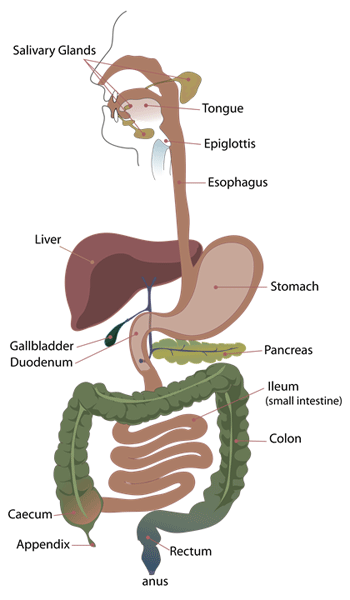I suppose that my interest in healthy eating would inevitably lead me to understand a bit more about my digestive system. After all, it’s responsible for processing the food I eat, extracting the nutrients to feed my body, and eliminating a lot of waste. So, to help the system do its job, it matters what I eat and how I eat it. But I never appreciated the complexity of the whole process until I read Dr. Michael Gershon’s book, The Second Brain.
It turns out that we have a distinct neural apparatus that runs our digestive operation. Dubbed the enteric nervous system, it contains over 100 million nerve cells to manage the precise chemical reactions necessary to get what we need from food while simultaneously defending the body from harmful substances. By giving our guts their own intelligence, our brains are free to address a myriad of others inputs, signals, decisions, and actions without worrying much about digestion.
Our brains play a role at the start of digestive process as we experience food through our senses (especially taste and smell), or even think about it. It causes us to excrete saliva that will moisten the food as we grind it with our teeth. It also signals the stomach to ramp up production of digestive juices. While we’re chewing, the enteric nervous system receives signals to indicate what’s coming down the line so the stomach can make preparations.
Note: The more we chew our food, the greater our ability to extract nutrients from it. Chewing also slows down food consumption to a pace at which our body has a chance to tell us when it has had enough to eat. It needs at least 20 minutes after chewing begins!
Muscles in the esophageal wall drive the food toward the stomach, entering through an opening at the esophageal sphincter. Once the material enters the stomach, it starts churning the food mechanically to transform large pieces into minuscule particles while subjecting them to potent gastric acids. Because these acids are as damaging to cellular tissue as they are to food particles, it takes a complex mechanism to regulate their production and secretion into the stomach. A thick mucosal layer protects the stomach lining from damage.
Note: The world’s healthiest, long-lived human beings eat to 80% of capacity, leaving plenty of room for the stomach to function effectively.
The stomach contents must be rendered to baby food consistency before they are deemed acceptable to the small intestine. The brain controls the pyloric sphincter which serves as the gateway between the stomach and small intestine. It empties into the small intestine as if feeding a baby – one small bite at a time. As such, the stomach serves as a storage facility for partially processed food until this rather slow process comes to fruition. Once all of the material has passed through the pyloric sphincter, the enteric nervous system runs the show.
Note: Now you know why the stomach can feel uncomfortably full for quite a while after an oversized meal!
The initial segment of the small intestine (a.k.a., duodenum) uses sensors to measure the pH of the incoming contents and leverages the enteric nervous system to signal for release of appropriate digestive enzymes by the pancreas. (All of that acid from the stomach must be neutralized!) The enteric nervous system also communicates with the liver and gall bladder (i.e., the storage repository for bile) to secure substances that emulsify fats so that digestive enzymes can process them.
The small intestine assumes primary responsibility for digestion and nutrient absorption. Folds in the intestinal lining combined with cellular projections on the cell walls (villi and microvilli) maximize the surface area through which absorption may occur. Tight junctions between cells in the lining keep undesirable materials from entering the bloodstream.
Note: For some individuals, certain foods cause the lining of the gut walls to lose their integrity. The resulting gaps allow oversized food particles and pathogens access to the bloodstream. Their entry sparks inflammation that may trigger an autoimmune response.
The small intestine transfers largely watery materials into the large intestine (a.k.a., colon). Of the roughly 2 gallons of water that the colon receives daily, all but 6-7 tablespoons are reabsorbed by the colon to prevent dehydration. Bacteria hang out in the colon and make up a good portion of excreted materials. Immune-competent cells in the lining shield the body from attack by “bad” bacteria. The brain steps back into action at the end of the line by regulating bowel movements.
Dr. Gershon provides insights on several common digestive ailments so that the reader can understand the biological mechanisms at play. I’ll confess that I didn’t explore all of them in detail. However, my elevated understanding of the entire system will certainly inform my food choices and eating habits going forward.
